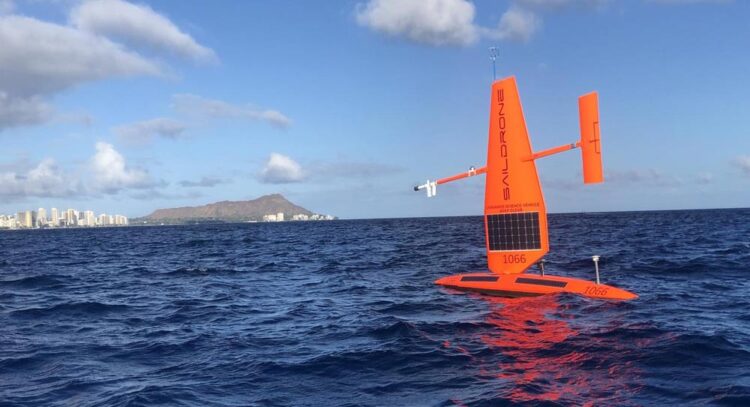Remotely-piloted sailboats monitor ‘cold pools’ in tropical environments

Saildrone uncrewed surface vehicles (USVs), like the one pictured here, made measurements of atmospheric cold pools in remote regions of the tropical Pacific.
Credit: Saildrone, Inc.
Conditions in the tropical ocean affect weather patterns worldwide. The most well-known examples are El Niño or La Niña events, but scientists believe other key elements of the tropical climate remain undiscovered.
In a study recently published in Geophysical Research Letters, scientists from the University of Washington and NOAA’s Pacific Marine Environmental Laboratory use remotely-piloted sailboats to gather data on cold air pools, or pockets of cooler air that form below tropical storm clouds.
“Atmospheric cold pools are cold air masses that flow outward beneath intense thunderstorms and alter the surrounding environment,” said lead author Samantha Wills, a postdoctoral researcher at the Cooperative Institute for Climate, Ocean and Ecosystem Studies. “They are a key source of variability in surface temperature, wind and moisture over the ocean.”
The paper is one of the first tropical Pacific studies to rely on data from Saildrones, wind-propelled sailing drones with a tall, hard wing and solar-powered scientific instruments. Co-authors on the NOAA-funded study are Dongxiao Zhang at CICOES and Meghan Cronin at NOAA.
Atmospheric cold pools produce dramatic changes in air temperature and wind speed near the surface of the tropical ocean. The pockets of cooler air form when rain evaporates below thunderstorm clouds. These relatively dense air masses, ranging between 6 to 125 miles (10 to 200 kilometers) across, lead to downdrafts that, upon hitting the ocean surface, produce temperature fronts and strong winds that affect their surroundings. How this affects the larger atmospheric circulation is unclear.
“Results from previous studies suggest that cold pools are important for triggering and organizing storm activity over tropical ocean regions,” Wills said.
To understand the possible role of cold pools in larger tropical climate cycles, scientists need detailed measurements of these events, but it is hard to witness an event as it happens. The new study used uncrewed surface vehicles, or USVs, to observe the phenomena.
Over three multi-month missions between 2017 and 2019, 10 USVs covered over 85,000 miles (137,000 kilometers) and made measurements of more than 300 cold pool events, defined as temperature drops of at least 1.5 degrees Celsius in 10 minutes. In one case, a fleet of four vehicles separated by several miles captured the minute-by-minute evolution of an event and revealed how the cold pool propagated across the region.
“This technology is exciting as it allows us to collect observations over hard-to-reach, under-sampled ocean regions for extended periods of time,” Wills said.
The paper includes observations of air temperature, wind speed, humidity, air pressure, sea surface temperature and ocean salinity during cold pool events. The authors use the data to better describe these phenomena, including how much and how quickly air temperatures drops, how long it takes the wind to reach peak speeds, and how sea surface temperature changes nearby. Results can be used to evaluate mathematical models of tropical convection and explore more questions, like how the gusts created by the temperature difference affect the transfer of heat between the air and ocean.
###
For more information, contact Wills at smwills@uw.edu
All latest news from the category: Earth Sciences
Earth Sciences (also referred to as Geosciences), which deals with basic issues surrounding our planet, plays a vital role in the area of energy and raw materials supply.
Earth Sciences comprises subjects such as geology, geography, geological informatics, paleontology, mineralogy, petrography, crystallography, geophysics, geodesy, glaciology, cartography, photogrammetry, meteorology and seismology, early-warning systems, earthquake research and polar research.
Newest articles

Innovative 3D printed scaffolds offer new hope for bone healing
Researchers at the Institute for Bioengineering of Catalonia have developed novel 3D printed PLA-CaP scaffolds that promote blood vessel formation, ensuring better healing and regeneration of bone tissue. Bone is…

The surprising role of gut infection in Alzheimer’s disease
ASU- and Banner Alzheimer’s Institute-led study implicates link between a common virus and the disease, which travels from the gut to the brain and may be a target for antiviral…

Molecular gardening: New enzymes discovered for protein modification pruning
How deubiquitinases USP53 and USP54 cleave long polyubiquitin chains and how the former is linked to liver disease in children. Deubiquitinases (DUBs) are enzymes used by cells to trim protein…



